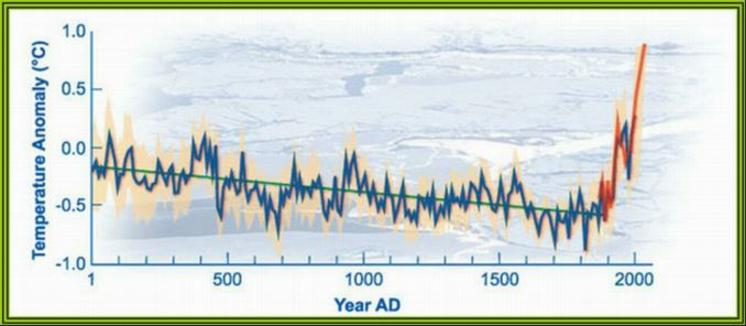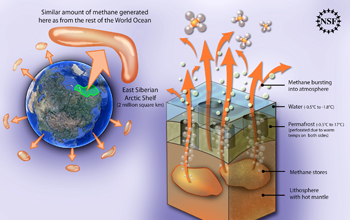The Press Release from the National Science Foundation, Mar 4, 2010:
The permafrost of the East Siberian Arctic Shelf (an area of about 2 million kilometers squared) is more porous than previously thought. The ocean on top of it and the heat from the mantle below it warm it and make it perforated like Swiss cheese. This allows methane gas stored under it under pressure to burst into the atmosphere.
A section of the Arctic Ocean seafloor that holds vast stores of frozen methane is showing signs of instability and widespread venting of the powerful greenhouse gas, according to the findings of an international research team led by University of Alaska Fairbanks scientists Natalia Shakhova and Igor Semiletov.
The research results, published in the March 5 edition of the journal Science, show that the permafrost under the East Siberian Arctic Shelf, long thought to be an impermeable barrier sealing in methane, is perforated and is starting to leak large amounts of methane into the atmosphere. Release of even a fraction of the methane stored in the shelf could trigger abrupt climate warming.
"The amount of methane currently coming out of the East Siberian Arctic Shelf is comparable to the amount coming out of the entire world's oceans," said Shakhova, a researcher at UAF's International Arctic Research Center. "Subsea permafrost is losing its ability to be an impermeable cap."
Methane is a greenhouse gas more than 30 times more potent than carbon dioxide. It is released from previously frozen soils in two ways. When the organic material (which contains carbon) stored in permafrost thaws, it begins to decompose and, under anaerobic conditions, gradually releases methane. Methane can also be stored in the seabed as methane gas or methane hydrates and then released as subsea permafrost thaws. These releases can be larger and more abrupt than those that result from decomposition.
The East Siberian Arctic Shelf is a methane-rich area that encompasses more than 2 million square kilometers of seafloor in the Arctic Ocean. It is more than three times as large as the nearby Siberian wetlands, which have been considered the primary Northern Hemisphere source of atmospheric methane. Shakhova's research results show that the East Siberian Arctic Shelf is already a significant methane source, releasing 7 teragrams of methane yearly, which is as much as is emitted from the rest of the ocean. A teragram is equal to about 1.1 million tons.
"Our concern is that the subsea permafrost has been showing signs of destabilization already," she said. "If it further destabilizes, the methane emissions may not be teragrams, it would be significantly larger."
Shakhova notes that the Earth's geological record indicates that atmospheric methane concentrations have varied between about .3 to .4 parts per million during cold periods to .6 to .7 parts per million during warm periods. Current average methane concentrations in the Arctic average about 1.85 parts per million, the highest in 400,000 years, she said. Concentrations above the East Siberian Arctic Shelf are even higher.
The East Siberian Arctic Shelf is a relative frontier in methane studies. The shelf is shallow, 50 meters (164 feet) or less in depth, which means it has been alternately submerged or terrestrial, depending on sea levels throughout Earth's history. During the Earth's coldest periods, it is a frozen arctic coastal plain, and does not release methane. As the Earth warms and sea level rises, it is inundated with seawater, which is 12-15 degrees warmer than the average air temperature.
"It was thought that seawater kept the East Siberian Arctic Shelf permafrost frozen," Shakhova said. "Nobody considered this huge area."
"This study is a testament to sustained, careful observations and to international cooperation in research," said Henrietta Edmonds of the National Science Foundation, which partially funded the study. "The Arctic is a difficult place to get to and to work in, but it is important that we do so in order to understand its role in global climate and its response and contribution to ongoing environmental change. It is important to understand the size of the reservoir--the amount of trapped methane that potentially could be released--as well as the processes that have kept it "trapped" and those that control the release. Work like this helps us to understand and document these processes."
Earlier studies in Siberia focused on methane escaping from thawing terrestrial permafrost. Semiletov's work during the 1990s showed, among other things, that the amount of methane being emitted from terrestrial sources decreased at higher latitudes. But those studies stopped at the coast. Starting in the fall of 2003, Shakhova, Semiletov and the rest of their team took the studies offshore. From 2003 through 2008, they took annual research cruises throughout the shelf and sampled seawater at various depths and the air 10 meters above the ocean. In September 2006, they flew a helicopter over the same area, taking air samples at up to 2,000 meters (6,562 feet) in the atmosphere. In April 2007, they conducted a winter expedition on the sea ice.
They found that more than 80 percent of the deep water and more than 50 percent of surface water had methane levels more than eight times that of normal seawater. In some areas, the saturation levels reached more than 250 times that of background levels in the summer and 1,400 times higher in the winter. They found corresponding results in the air directly above the ocean surface. Methane levels were elevated overall and the seascape was dotted with more than 100 hotspots. This, combined with winter expedition results that found methane gas trapped under and in the sea ice, showed the team that the methane was not only being dissolved in the water, it was bubbling out into the atmosphere.
These findings were further confirmed when Shakhova and her colleagues sampled methane levels at higher elevations. Methane levels throughout the Arctic are usually 8 to 10 percent higher than the global baseline. When they flew over the shelf, they found methane at levels another 5 to 10 percent higher than the already elevated Arctic levels.
The East Siberian Arctic Shelf, in addition to holding large stores of frozen methane, is more of a concern because it is so shallow. In deep water, methane gas oxidizes into carbon dioxide before it reaches the surface. In the shallows of the East Siberian Arctic Shelf, methane simply doesn't have enough time to oxidize, which means more of it escapes into the atmosphere. That, combined with the sheer amount of methane in the region, could add a previously uncalculated variable to climate models.
"The release to the atmosphere of only one percent of the methane assumed to be stored in shallow hydrate deposits might alter the current atmospheric burden of methane up to 3 to 4 times," Shakhova said. "The climatic consequences of this are hard to predict."
By The way, this article was linked a series of others, which say, among other things, that the permafrost in the tundra is also melting faster than expected, and that boreal forests are already beginning to grow further north, which means of course we have dark trees absorbing heat where Arctic snow used to reflect it...
And you wonder why I'm an Alarmist?
My Prediction of multiple major climactic disatsters looks more and more likely - if Mother Nature doesn't trump me and bring it on earlier...


" Release of even a fraction of the methane stored in the shelf could trigger abrupt climate warming."
ReplyDeleteHere's that key term again: abrupt.
'Abrupt' means no time for adaption. Abrupt means no time for innovation in energy change. Abrupt means death for entire plant and animal ecosystems and for millions of people.
Lets hope that climate change is mostly man-caused, because if it isn't, and methane feedback becomes a runaway natural mechanism, then extreme warming is very probable, with all that entails for global life of all types.